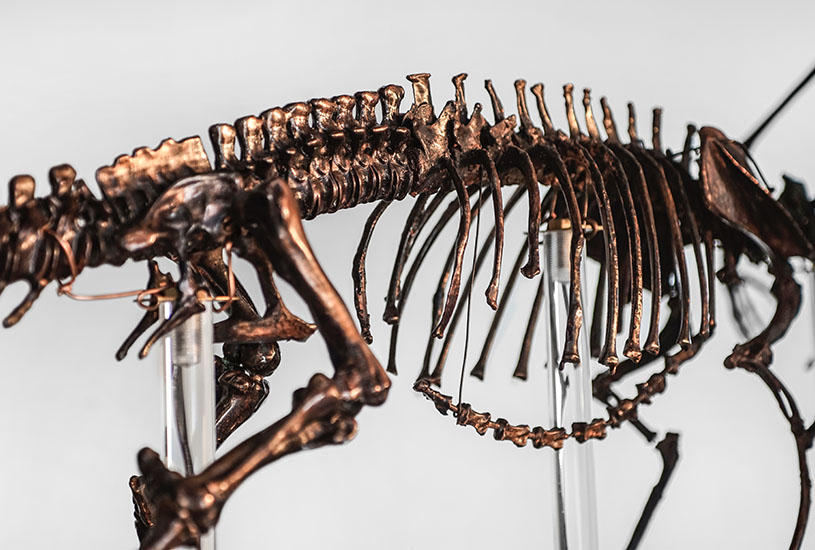Victoria’s very own dinosaur is coming to life in a unique exhibition at the National Wool Museum.
What did dinosaurs’ skin feel like? What colour were they in real life? It’s difficult to tell from fossils, but with the expertise of palaeontologists and engineers, visitors to a unique exhibition at the National Wool Museum in Geelong can interact with the dinosaur that once roamed our backyard.
‘The Little L Project’ showcases Victoria’s state dinosaur ‘Leaellynasaura amicagraphica,’ a wallaby- sized herbivore who called the Otway Ranges home around 106 million years ago. Named after the daughter of her discoverers, renowned palaeontologists Patricia Vickers-Rich AO and Tom Rich, Leaellynasaura, or ‘Little L’, was a polar dinosaur living in the vast river valley that spread from Australia to Antarctica.
However, this is not the usual dinosaur exhibition of fossils in glass boxes and replica skeletons. ‘The Little L Project’ has brought together Deakin University’s School of Engineering, the National Wool Museum, Swinburne University’s PrimeSci, and Museums Victoria to develop a ‘mixed reality’ museum experience, blending the physical and digital worlds for the first time.
“We’ve pushed the boundaries to not only allow people to interact with ‘Little L’ in virtual reality, but to be able to simultaneously touch a 3D printed Leaellynasaura,” said project co-creator Dr Ben Horan, Director of Deakin’s CADET Virtual Reality Laboratory.
Visitors to ‘The Little L Project’ can touch 3D printed samples of Little L’s skin, experience the sights and sounds of an archaeological dig near Cape Otway through virtual reality (VR) and choose which colour to ‘paint’ Little L’s skin through a combination of VR, 3D printing, and haptic technologies.
While many people colour the dinosaur as brightly as they can from the selection on offer in the virtual pallet, others pay more attention to how palaeontologists and paleo artists deduce from the environment what colour dinosaurs may have been.

Virtual reality, 3D printing and haptic technologies on offer at the ‘Little L Project’
These are museum visitors as research participants – the exhibition is, in fact, a living pilot research project exploring how VR and augmented reality technology can enhance the experience of museum visitors.
‘In the past, people are only visiting the museum to look at things, which is not as appealing to new generations,” said co-creator Dr Kaja Antlej, Lecturer in Industrial Design with Deakin’s School of Engineering and a digital heritage expert.
‘We want to explore ways to use these technologies, from VR to augmented reality to 3D printing to deliver new learning channels that actively engage visitors and turn them into participants in, and co-creators of, the experience. That is one of the questions in this research – how do we put all these technologies together in order to do this?’
‘Not without challenges,’ is the answer; and the pilot project will use the data collected from participant surveys to iron out any glitches and improve the experience in future versions of the exhibition.
‘Mixed reality using 3D printing to interact with haptics is innovative – there are not too many people doing that and there were issues to overcome. We had to align the two worlds to make sure that what people see and experience in VR corresponds to what they feel in the physical world, or we can end up in “uncanny valley”, which is where things are not quite right in VR and the immersion is broken,” Dr Horan explained.
‘It hasn’t been only about successfully developing the technology: getting it ready for the public as well has required us to very carefully engineer the experience.’
Dr Antlej, who has spent hours in the gallery space patiently teaching exhibition visitors how to use the virtual pallet to paint Little L while demonstrating how to adapt the technology to different size hands and different heights, says the experience has been invaluable.
“You can’t perfect the technology using only the experts in the lab,” she said, while showing a small boy how to stab his finger ‘through’ the colour selection ‘buttons’, rather than press them.
[testimonial_text]We need to see and evaluate how actual visitors interact with the technology; we need to test in the actual environment the best way to communicate our ideas through the technology.[/testimonial_text]
[testimonial_picture name=”Dr Kaja Antlej” details=”Deakin University School of Engineering”]
 [/testimonial_picture]
[/testimonial_picture]Dr Horan, Dr Antlej and their team worked closely with Professor Vickers-Rich and Dr Tom Rich to bring Little L to life, particularly when it came to rendering her skin and scales in 3D. There are no fossils of Little L’s skin, but clues lie in the scales of the eastern blue tongue lizard and a North American dinosaur that left behind impressions of its skin when it died millions of years ago.
‘Professor Vickers-Rich’s lifelong goal is to help people understand more about dinosaurs – in this case the dinosaurs that roamed in their own backyard – and she wanted to work together to think about ways to approach that using all this technology,’ Dr Horan said.
For Dr Antlej, a challenge and joy of the project has been the requirement for interdisciplinary research and co-operation.
‘We have scientists, museum professionals, the local community, engineers and designers involved in this project, and each has their own role. We couldn’t do the project without any of them,’ she said.
The ‘Little L Project’ is at the National Wool Museum until Sunday 15 April 2018.
For more information, visit www.nwm.vic.gov.au
Read more about the project:
- www.deakin.edu.au/about-deakin/news/articles/walking-with-australian-dinosaurs-in-virtual-reality
- www.deakin.edu.au/research/research-news/articles/prehistoric-remnants-transformed-into-futuristic-experience
Main photograph (left to right): Mr Robert Leen, Associate Professor Ben Horan, Dr Kaja Antlej, Professor Karen Hapgood, Ms Robynne Hall, Mr Benjamin Champion, Mr Padraic Fisher, Director National Wool Museum, Mr Gokul Thirunavukkarasu, Ms Marie Allaman, Little L Project Curator National Wool Museum.
Photo: Joel Carnegie, National Wool Museum.
Published by Deakin Research on 29 March 2018



